
CHECKING TRACK-RECORD Previous explorations projects and discoveries are important in considering the residual prospectivity of a given mineral province
Targeting science is a key application in economic geology, as it is aimed at translating knowledge about minerals into mappable proxies. This is done along with the integration of constraints imposed by previous exploration, as well as developing and evaluating methodologies of data interaction to prioritise targets.
This is according to Council for Geoscience (CGS) economic geology specialist scientist John Paul Hunt, who was speaking at the recent CGS 2016 conference, which was held at the Council for Scientific and Industrial Research International Convention Centre, in Tshwane.
He said that previous exploration projects and discoveries were important in considering the residual prospectivity of a given mineral province.
“To assess the potential of minerals, particularly in areas where research has already taken place, it is vital to understand the expected target size and value that might be derived from an undiscovered deposit,” Hunt stated.
Moreover, he pointed out that it was important to know whether the expected target met the predetermined minimum criteria regarding its size. Hunt said that this knowledge directly informed exploration strategy and design.
He explained that the size-frequency relationship for mineral deposits generally followed an inverse power law distribution at various scales from global, to province to district level.
“This means that most of the value of an ore system will be contained by the largest deposit. Generally, such deposits tend to have the largest signature and can, thus, be expected to be found at an early stage in the exploration endeavour,” commented Hunt.
He further remarked that in some instances, as in the case of a “well-sampled” exploration target, the previous exploration was an important guide in determining residual potential.
Endowment in terms of residual minerals may be modelled by applying a rank statistical of known deposits using Zipf’s law to identify potential undiscovered deposits. Hunt explained that Zipf’s law was an empirical law formulated using mathematical statistics, which referred to the fact that many types of data studied can be estimated with a Zipfian distribution (a set of related discrete power law probability distributions).
He said that this analysis could also reveal that the exploration area may need to be expanded or even changed.
Re-Evaluating Historic Mining Areas in South Africa
Meanwhile, Hunt highlighted that the Barberton greenstone belt, in Mpumalanga, had been mined for gold since 1884 and had produced in excess of 8-million ounces of gold, while declared resources added 8-million additional ounces of gold to this total.
He pointed out that the five largest deposits fit the theoretical distribution line well, which suggested that the area’s resources had largely been accounted for.
However, Hunt said that according to Zipf’s law, about one-third of Barberton’s gold endowment was currently unaccounted for. Therefore, he contended that there should be an additional ten deposits in the range of 10 000 kg to 30 000 kg of gold.
“Ignoring important economic considerations for the time being, such as depth of mineralisation, orebody continuity, or mining and metallurgical constraints, for junior explorers and small-scale miners, this area may still represent a viable target and warrants continued exploration for additional discovery.
“With a clearer understanding of the potential residual target size, exploration programmes can be designed to provide maximum value creation within this mature terrain,” he concluded.